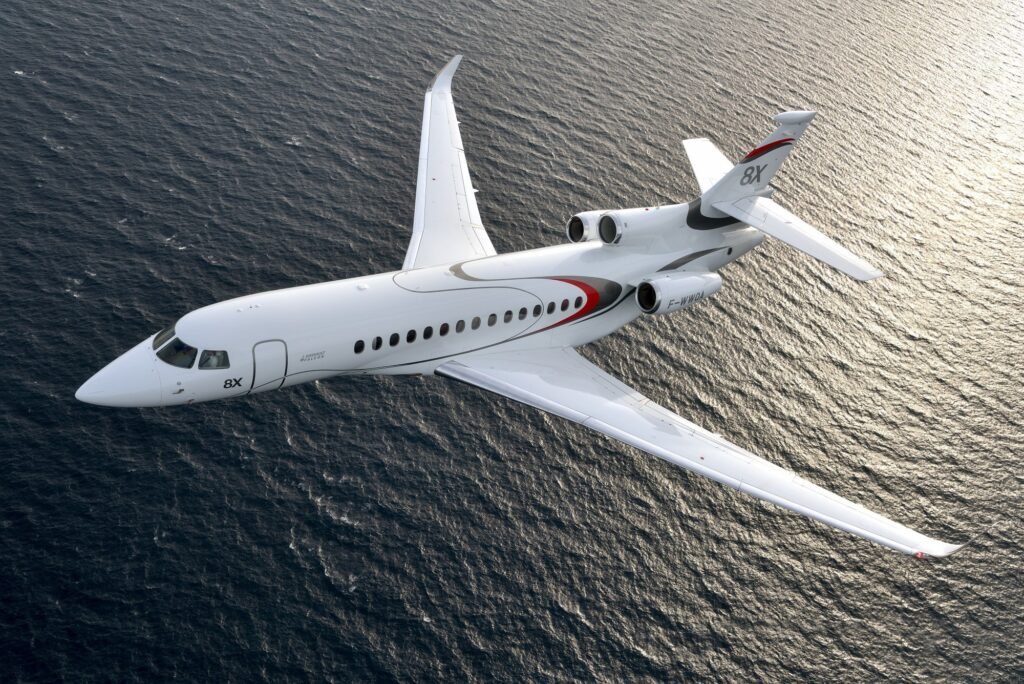In the world of private aviation, few names carry the weight of Dassault. Because of its military aircraft history and outstanding business jets, Dassault Aviation had great success with the Falcon 7X in 2005. It was the first business jet to come with a digital system for controlling flights and 3 engines which made it safer and more versatile. But as people began looking for flights with larger ranges and even finer onboard experiences, Dassault understood they had to aim higher.
Because of this big idea, the concept of Dassault Falcon 8X came and marked a considerable evolution from the Falcon 7X. Dassault didn’t just stretch the fuselage or tweak the engines. Instead, the 8X was designed as a complete rethinking of what an ultra-long-range business jet could be, bringing more power, more space, and more capability to the skies.
Why Dassault Needed the Falcon 8X
In the 2010s, Dassault started to feel more pressure in the ultra-long-range jet category. The success of the Gulfstream G650 and its great speed and distance was grabbing the attention of the very wealthy, just as Bombardier was doing with its Global line. Although the Falcon 7X did well, its range and inside space were beginning to seem below what customers were looking for. Customers loved the idea of flying far without having to stop and they looked forward to relaxing or working comfortably in the plane.
At the core of Dassault’s marketing and design teams, engineers highlighted that what they needed was a new flagship jet that kept the essence of the Falcon 7X and improved it more widely. Instead of calling it just an upgrade, the 8X project was described as a “performance and luxury amplifier” by employees. The engineers aimed to design a jet that kept its operational capabilities, but also explored markets previously dominated by North American brands.
It was not only focused on building an aircraft that could fly farther. This meant Dassault underlining its character by mixing French style, outstanding performance and business-friendly qualities together. To succeed in a tough market, the Falcon 8X was necessary and that’s how it first started to be designed.
Launching the Falcon 8X Program
The Falcon 8X program was presented to the public in May 2014. Dassault wanted to compete directly with models like the Gulfstream G650 and Bombardier Global 6000 when they developed the MSN. The program started by trying to get the best performance in terms of efficiency, inside the cabin and new technology without losing the classic Dassault handling.
At its Bordeaux-Mérignac plant in France, Dassault introduced the first prototype of the Falcon 8X on May 19, 2014. The aircraft registered as F-WWQA made its first flight on February 6, 2015. With this flight, a substantial testing program began that involved several different continents. At the end of over 830 hours of test flights and more than 400 test missions, EASA and the FAA approved the aircraft in June 2016. Just after that, delivery started and people based in Europe, the U.S., the Middle East and Asia immediately became curious about the new product.
The Engineering Behind the Falcon 8X
A Powerful Tri-Engine Configuration
One of the most distinguishing features of the Dassault Falcon 8X is its tri-engine configuration. The Dassault Falcon 8X is notable for having three engines instead of the usual two. The jet is powered by three Pratt & Whitney Canada PW307D turbofan engines which provide a total thrust of more than 20,000 pounds. The engines give 6,722 pounds of thrust and are about 15% more efficient when it comes to fuel usage compared to the 7X’s PW307A. Because of these enhancements, the 8X is capable of traveling a remarkable 6,450 nautical miles (11,945 kilometers) which means it can link Beijing to Paris or São Paulo to Moscow without a stop.
It takes 347 gallons of fuel to power the wings for just one hour which is amazing for an aircraft of its size. Adding an extra engine means the plane can take off safely from both short and hot runways and that there is added safety during overwater flights.
Advanced Aerodynamics and Airframe Efficiency
The fuselage of the Falcon 8X is 3.5 feet longer than the 7X which increases cabin space while maintaining the airplane’s efficient aerodynamics. Engineers from Dassault worked on the wings, used lighter materials and fitted them to reduce drag. They make the aircraft fly farther, use fuel more efficiently and remain firm while flying high.
The maximum height the aircraft can reach is 51,000 feet and it cruises at Mach 0.80 comfortably, with a top speed of Mach 0.90. The weight at takeoff can be 73,000 pounds and at landing, the weight must be no more than 62,000 pounds. This jet is able to become airborne after just 5,880 feet of runway, so it can use smaller airports than other business jets.
Cockpit Technology and Avionics Excellence
The EASy IV Flight Deck
The Falcon 8X has an improved flight deck called the EASy IV which was developed in collaboration with Honeywell. All flight controls and displays come together in an intuitive way on one system, making it easier and safer for pilots to operate the aircraft. Large high-quality screens supply pilots with detailed data on navigation, weather and aircraft systems. Thanks to FalconEye Combined Vision System, pilots can easily see the landing area using infrared and synthetic vision which improves their safety when flying in bad conditions. All of this together makes flying safer and takes stress off the pilots.
FalconEye and Sidestick Control
One of the greatest additions in the Falcon 8X cockpit is the FalconEye Combined Vision System. The system brings together synthetic vision and better real-world vision using infrared sensors which allows pilots to be very alert about their surroundings during low-visibility landings. This is the first aviation system in business aviation to get clearance for landing in low-visibility conditions.
The Falcon 8X uses sidesticks instead of the traditional yoke system found in Boeing aircraft which improves the pilot’s view by placing the controls on the console’s edges. Because of these design choices, many pilots describe this as one of the most intuitive cockpits in private aviation.
A Step Toward Sustainable Flight
The Falcon 8X was created by Dassault with sustainability in focus. The jet is approved to fly on Sustainable Aviation Fuel (SAF), so carbon emissions are lower than those from traditional jet fuel. Its efficient Pratt & Whitney engines and aerodynamic design also contribute to lower fuel consumption. They match Dassault’s desire for sustainable business aviation, improving the 8X’s fuel efficiency and its green performance.
Unmatched Cabin Experience at 51,000 Feet
You can work, relax and even entertain in the comfortable and luxurious cabin of the Dassault Falcon 8X. The 42.6 feet in length, 6.2 feet in height and 7.7 feet in width allow the cabin to be set up in more than 30 different styles. Around the deck, customization options cover conference space, separate rooms, a shower-equipped bathroom and lounges.
Low cabin altitude is one of the greatest things about this aircraft. You’d never guess by the way it feels that you’re more than three miles high when you’re inside an airplane. It greatly lessens tiredness during long trips and makes travel more relaxing. Also, thanks to sophisticated insulation and airflow, noise is kept to a minimum in the cabin which is especially quiet. Through the mobile app, guests can choose their preferred interior temperature, lighting and entertainment, with everything staying comfortable for them.
Market Performance and Global Reception
When it was introduced in 2016, the Dassault Falcon 8X was appreciated by both private and government customers. Even though Gulfstream’s G650 and Bombardier’s Global 7500 are more popular, many 8X buyers appreciate its performance, economy and the quality of European manufacturing.
Operators, government officials and very wealthy individuals from many countries use the 8X because of its versatility and long-distance performance. Because of its trijet design, it is popular in places where airports are not well-developed, because it can take safer routes in the event of an engine problem. The aircraft is supported by Dassault’s worldwide service network and its strong focus on service after the sale which is valued by both corporate fleets and individual owners.
Pricing, Pre-Owned Market, and Charter Options
The base price for the Dassault Falcon 8X is nearly $60 million which shows it is meant for experienced and well-funded aviation users. Even so, the good service and worldwide coverage make it a good choice for people who fly a lot and want access to far-away places. For more than $65 million, a buyer can get an executive jet with every possible accessory inside and robust electronics.
The used market has aircraft for sale starting at around $43 million, but the price depends on various details such as configuration, engine hours and history of maintenance. Maintaining jets and understanding their maintenance history matter a lot when selling. For people who aren’t yet ready to own a jet, chartering the Falcon 8X is widely preferred. Those who charter can enjoy how much space there is, fast journey times and luxury fittings, all without having to spend on a lengthy purchase, good for travelers and those on business trips.
Final Thoughts: The Dassault Falcon 8X Legacy
The Dassault Falcon 8X reflects Dassault’s highest engineering goals. Instead of being a lengthened version of its predecessor, it features the latest avionics, environmentally friendly technology and superior cabin comfort packed into one refined plane.
Whether you’re flying it across oceans or into short runways at remote airfields, the Falcon 8X is a symbol of versatility and prestige. For discerning buyers who seek a blend of range, performance, and understated luxury, it remains one of the most compelling aircraft in the ultra-long-range segment.



